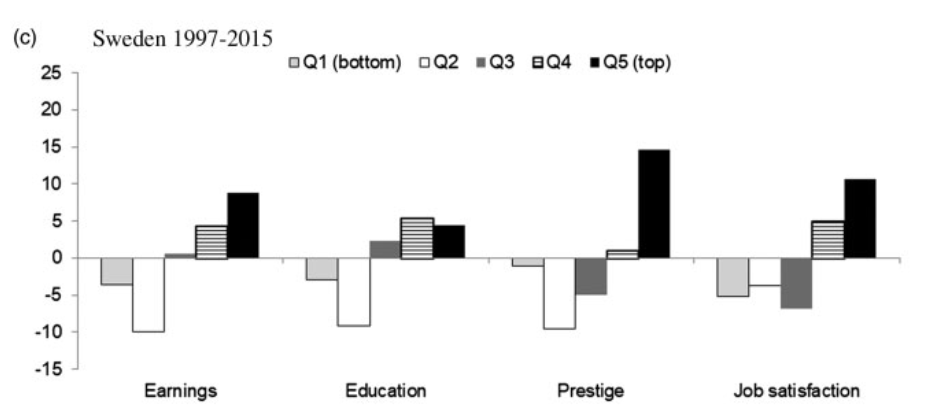Jobbpolarisering?
Kul ny artikel: Oesch, D., & Piccitto, G. (2019). The Polarization Myth: Occupational Upgrading in Germany, Spain, Sweden, and the UK, 1992–2015. Work and Occupations, 46(4), 441–469. https://doi.org/10.1177/0730888419860880
Ur abstract:
The consensus view in economics is that labor markets are polarizing as job creation takes place in high-skilled and low-skilled occupations, while jobs shrink in midskilled ones. The authors argue that ... polarization runs counter to all the trends that shaped the job structure over the past decades: skill-biased technological change, the international division of labor, and educational expansion.
The authors then show that the polarization thesis does not hold empirically. They use the European Labor Force Survey to analyze occupational change for Germany, Spain, Sweden, and the United Kingdom from 1992 to 2015 and define good and bad occupations with four alternative indicators of job quality: earnings, education, prestige, and job satisfaction. Job growth was by far strongest in occupations with high job quality and weakest in occupations with low job quality, regardless of the indicator used. The authors find clear-cut occupational upgrading for Germany, Spain, and Sweden. In the United Kingdom, the data support the polarization thesis when job quality is measured with earnings.
The authors then show that the polarization thesis does not hold empirically. They use the European Labor Force Survey to analyze occupational change for Germany, Spain, Sweden, and the United Kingdom from 1992 to 2015 and define good and bad occupations with four alternative indicators of job quality: earnings, education, prestige, and job satisfaction. Job growth was by far strongest in occupations with high job quality and weakest in occupations with low job quality, regardless of the indicator used. The authors find clear-cut occupational upgrading for Germany, Spain, and Sweden. In the United Kingdom, the data support the polarization thesis when job quality is measured with earnings.
Måttet är absolut sysselsättningsförändring, och så här beskriver de resultaten:
Regardless of the indicator used, job growth was strongest, in all four countries, in the occupations of Quintile 5 where job quality is highest. The proportion of employment in these top-end occupations increased by roughly 10 percentage points—from 20% at the beginning of the 1990s to about 30% in 2015. In parallel, the employment share of the three bottom quintiles declined each by 3 to 5 percentage points.
Så här ser det ut för Sverige:
Employment change across job quality quintiles (in percentage points).

comments powered by Disqus